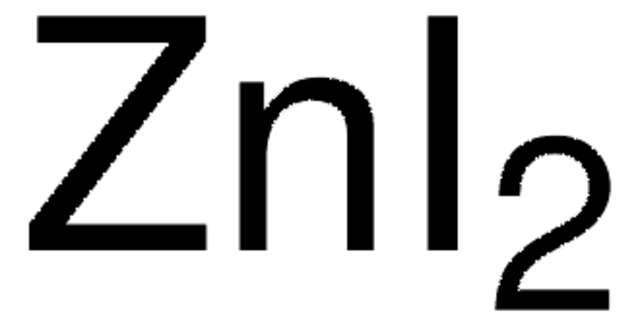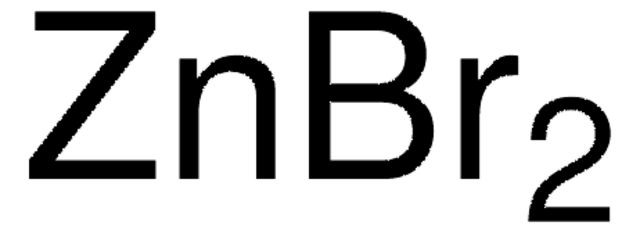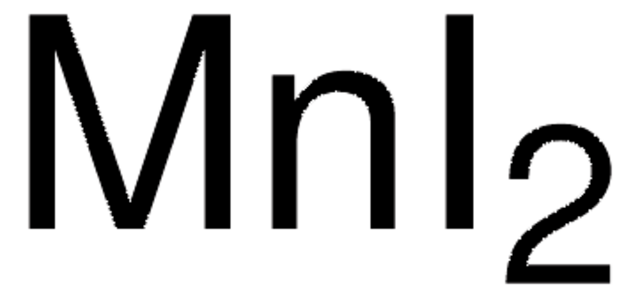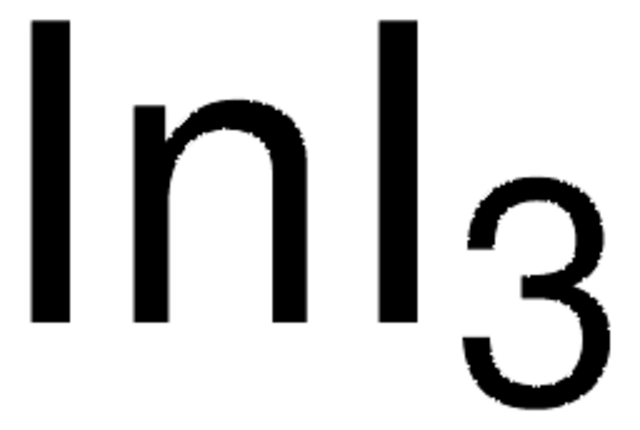Wichtige Dokumente
230014
Zinkiodid
≥99.99% trace metals basis
Synonym(e):
Diiodzink, Zinkdiiodid
About This Item
Empfohlene Produkte
Qualitätsniveau
Assay
≥99.99% trace metals basis
Form
crystalline
Eignung der Reaktion
reagent type: catalyst
core: zinc
Verunreinigungen
≤100.0 ppm Trace Metal Analysis
mp (Schmelzpunkt)
445 °C (lit.)
Dichte
4.74 g/mL at 25 °C (lit.)
SMILES String
I[Zn]I
InChI
1S/2HI.Zn/h2*1H;/q;;+2/p-2
InChIKey
UAYWVJHJZHQCIE-UHFFFAOYSA-L
Suchen Sie nach ähnlichen Produkten? Aufrufen Leitfaden zum Produktvergleich
Allgemeine Beschreibung
Anwendung
- An electrolyte in Zinc-iodine redox flow batteries.
- An additive to prepare air-stable cationic lead perovskite films. The addition of ZnI2 enhances the film stability and photoluminescence without affecting the bandgap.
- As a precursor to prepare efficient, eco-friendly, and high color purity inkjet-printed blue InP/ZnS/ZnS quantum dot light-emitting diodes.
- A catalyst in promoting various chemical transformations, for example, in the direct synthesis of 2,3-Dihydroisoxazoles via a [3+2] cycloaddition reaction of the nitrones and terminal alkynes.
- An activator/initiator in living cationic polymerization reactions.
Signalwort
Warning
H-Sätze
Gefahreneinstufungen
Aquatic Acute 1 - Aquatic Chronic 1 - Eye Irrit. 2 - Skin Irrit. 2 - STOT RE 2 Oral
Zielorgane
Thyroid
Lagerklassenschlüssel
13 - Non Combustible Solids
WGK
WGK 3
Flammpunkt (°F)
Not applicable
Flammpunkt (°C)
Not applicable
Persönliche Schutzausrüstung
Eyeshields, Faceshields, Gloves, type P3 (EN 143) respirator cartridges
Hier finden Sie alle aktuellen Versionen:
Besitzen Sie dieses Produkt bereits?
In der Dokumentenbibliothek finden Sie die Dokumentation zu den Produkten, die Sie kürzlich erworben haben.
Kunden haben sich ebenfalls angesehen
Artikel
Colloidal quantum dots (CQDs) are semiconducting crystals of only a few nanometers (ca. 2–12 nm) coated with ligand/surfactant molecules to help prevent agglomeration.
Unser Team von Wissenschaftlern verfügt über Erfahrung in allen Forschungsbereichen einschließlich Life Science, Materialwissenschaften, chemischer Synthese, Chromatographie, Analytik und vielen mehr..
Setzen Sie sich mit dem technischen Dienst in Verbindung.











